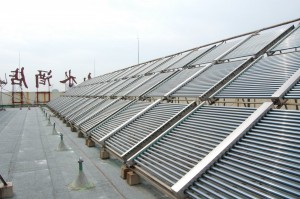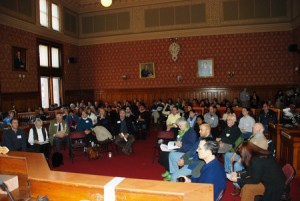Energy planning ought to be about avoiding problems and seizing collective opportunities. Cities (and nations) have problems when there is not enough energy available at a reasonable price. And, if they could get their act together, cities, regions, states and countries could reduce wasteful patterns of energy use and take advantage of “greener” energy production technologies that reduce costs of all kinds—especially environmental cost—and increase energy independence (i.e. reducing our dependence on “foreign” oil). Energy planning is about figuring out the best way to match energy supply and energy demand in sustainable ways. It gets complicated, though, because different groups have their own ideas about (1) the desirability of relying on various sources of energy; (2) the desirability of relying primarily on markets to set prices, encourage technology innovation and meet long-term needs, and (3) the appropriateness of allowing some groups and countries to tightly control certain energy supplies. In the final analysis, negotiations at the international, national, state, regional and local levels determine which energy supplies are available and what price we pay to meet our growing demand for electricity, transportation, home heating, and economic production.
Imagine a pie chart that shows the composition of our current energy supplies. We can do this at any scale. Let’s think about the country as a whole. Coal, oil, natural gas, nuclear energy, renewables (like solar and wind power), and a few other sources each constitute a wedge. A similar-sized pie chart shows how we use energy: industrial uses, residential uses, transportation, commercial uses, and the like. Supply and demand must be in balance in the sense that we can only use what we are able to find and pay for.
If you ask what the supply and demand pie charts will look like at a certain point in the future, say 10 years from now, there is no correct answer. Different groups will prefer a different mix of energy supplies and want to reshape energy demand, either because a shift will benefit them directly or because they are committed to improving the net overall impact on society in some way. One thing is for sure, though, experts can’t tell us what the pie charts ought to look like. We have to make those decisions for ourselves.
If it were up to you, how would you want to alter the pie charts for the United States? The current supply is made up of about 29% coal, 16% oil, 31% natural gas, 12% nuclear, and 11% renewables (including hydro). Current demand includes 30% industrial, 22% residential, 28% transportation, and 19% commercial. The overall price of energy is just over 9 cents per kilowatt, although not everyone pays the same price. The environmental costs of current energy use and production are hard to calculate. Sometimes these are framed in terms of impacts on public health: x people die or get sick each year from diseases associated with pollution of various kinds caused by energy production and utilization. Increasingly environmental costs will be framed in terms of what we would have to spend to artificially do the work that ecosystem do naturally like filter air and water or convert CO2 to oxygen. These are called ecosystem services and we can price them.
Any change in the overall size of the “pie” will effect certain groups—either changing the price they have to pay for a unit of energy, redistributing job opportunities, reshaping environmental costs, or altering the balance of power in the world. Someone’s got to pay for investments in new technology if we want to grow the pie or change the size of a supply or demand wedge.
Efforts at present, at the city level for instance, to change the pattern of energy supply and demand include (1) reducing the amount of energy used by municipal governments; (2) encouraging individual homeowners and businesses to conserve energy and reduce their carbon footprints; (3) encouraging more energy efficient patterns of land use and development, and (4) looking for ways to encourage more sustainable electricity production (through re-use of brownfields for renewable energy, building trash-to-energy plants and the like). In a big city, these can have a noticeable effect. Overall, though, states and national governments will have to get involved or the larger pie charts won’t look very different in the future than they do now. In recent years, states have begun to require that at least 20% of the electricity produced within their borders come from renewable energy sources by 2020 or 2030. We’ll see whether these provisions are enforces. If they are, the size of the renewable energy wedge could double in the national supply chart.
Unfortunately, we don’t have proper forums in which we can work out agreements on how existing supply and demand pie charts should look in the future. Congress has never faced this issue directly; preferring instead to make incremental decisions about whether to subsidize one form of energy development or not (often, at one location at a time). As a nation, we have not set supply or demand goals; instead, we have just bumped along. As I mentioned, states have been trying to encourage investment in cleaner forms of energy production, but they are limited by the grid—the system of power lines that allows energy produced and stored in one location to be “wheeled” to other locations as demand ebbs and flows. We need a national plan to expand and modernize the grid. We also need to figure out how to store and distribute highly distributed forms of (renewable) energy. We need to decide whether we are going to maintain or increase our reliance on nuclear energy even if we don’t have a plan for storing high level nuclear waste.
If states try to change energy efficiency standards or subsidize new forms of energy production, they end up competing with each other. Localities are even more highly constrained. They can improve energy efficiency in public buildings, increase the efficiency of the municipal bus fleet and work with building owners to encourage retrofits that reduce the demand for energy. They can also urge residents to use less energy. But, most are not about to get involved directly in producing energy on their own. If we allow more drilling, maybe we can increase our reliance on oil and gas. But, how do we do that and decrease greenhouse gas emissions at the same time? Can we assume that technology innovation (i.e. clean coal technology or carbon sequestration) will resolve that apparent conflict?
What would it mean to create national, state and local forums in which we could negotiate agreements regarding the changes we want to achieve in the current supply and demand pie charts? At each level, we would have to bring together representatives of all the relevant interests groups, engage in joint fact finding (with the help of appropriately qualified experts), formulate comprehensive agreements regarding five, ten and twenty year objectives and commit to appropriate implementation strategies. These conversations would not be easy. It is hard to formulate overall “packages” that will leave everyone better off. Discussions of this sort need to be mediated by qualified consensus building professionals. At the national level, the Department of Energy could take the lead (in cooperation with the appropriate Congressional committees) but a great many other groups would have to be involved. At the state level, governors and legislative leaders could convene appropriate consensus building efforts, but first we would need to figure out how to define the scope of state energy policies and how they fit within certain national decisions. In every city, broadly-representative working groups would need to consider possible changes in their supply and demand objectives within the framework of state and national plans. Final decisions would be made, of course, by those with the legal authority to make them, but to ensure implementation, the trade-offs and shifting distribution of gains and losses would need to have broad political support.
In the end, energy policies and plans are political choices that ought to reflect the best possible scientific, economic and engineering inputs. Our traditional approach to making public policy—careening from one crisis to the next—won’t produce the interlocking decisions required. We need to commit to a consensus building approach to energy planning.
 China exceeded U.S. investment in clean energy for the first time last year with deployments totaling $34.6 billion. The country still has a long way to go to clean up it’s emissions—China surpassed the US as the global leader in C02 emissions several years ago—but they’re moving quickly to clean up their act.
China exceeded U.S. investment in clean energy for the first time last year with deployments totaling $34.6 billion. The country still has a long way to go to clean up it’s emissions—China surpassed the US as the global leader in C02 emissions several years ago—but they’re moving quickly to clean up their act.









